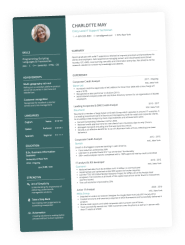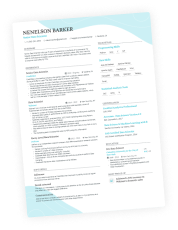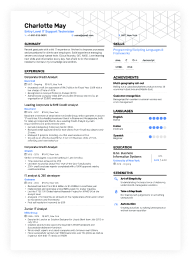Nobody likes talking about failure—especially when your dream job is on the line. But that’s exactly why interviewers ask, “Tell me about a time you failed.” It’s not about exposing your flaws. It’s about revealing your growth.
As leadership expert John C. Maxwell put it, “Fail early, fail often, but always fail forward.” Interviewers aren’t judging the failure itself—they’re listening for how you respond, recover, and reflect.
At Enhancv, we’ve helped thousands of candidates turn their setbacks into strengths. Whether you're just starting out or stepping into senior roles, this guide is packed with proven frameworks, real-world examples, and insider insights to help you answer this question with clarity, confidence, and credibility.
Key takeaways
- This question isn’t about the failure but how you grow from it. Employers want to see emotional intelligence, accountability, and resilience.
- The STAR method is your best tool for telling a clear, confident story. Focus on what happened, what you did, and what changed.
- Choose mishaps that are real, relevant, and recoverable. Avoid extremes, vague stories, or examples with no clear resolution.
- Frame your story with positive, constructive language. You don’t have to say “failure”—what matters is how you handled the challenge and what you learned.
- Tailor your story to the role you want. Whether you're applying for a leadership, technical, or client-facing position, choose a narrative that fits the challenges of the job.
Not sure if your resume is interview-ready? Run it through our free Resume Checker and find out in seconds.
Is your resume good enough?
Drop your resume here or choose a file. PDF & DOCX only. Max 2MB file size.
What recruiters mean by “Tell me about a time you failed”
“Tell me about a time you failed” is a classic behavioral interview question. It’s not theoretical—it’s meant to reveal how you’ve actually handled setbacks in the real world.
Behavioral questions like this are used to uncover more than just experience. They help employers see how you reflect, adapt, and grow from challenges.
What recruiters are looking to assess:
- Your emotional intelligence: Can you recognize and take ownership of your mistakes?
- Your self-awareness: Do you understand how your actions influence outcomes?
- Your growth mindset: Do you learn from mishaps, or get stuck in them?
- Your problem-solving skills: How do you respond when things go off track?
- Your sense of accountability: Do you take responsibility or shift blame?
- Your resilience: Can you bounce back stronger after a failure?
A strong answer shows that you’re coachable, accountable, and resilient. In other words, someone they want on their team.
Now let’s walk through exactly how to craft an answer that checks every box, without sounding overly rehearsed.
How to answer “Tell me about a time you failed”—the best strategies
Responding to this question well is about showing reflection, responsibility, and recovery.
Here are the six top strategies that help you do just that, along with example answers to bring each one to life.
1. Use the STAR method to structure your story
The STAR method (Situation, Task, Action, Result) helps you deliver a clear, concise answer with built-in logic. It shows that you can break down a problem and communicate effectively—skills every hiring manager values.
PRO TIP
The STAR method is the most common framework for answering interview questions because it mirrors how decision-makers evaluate performance:
What was the challenge, what did you do, and what changed as a result?
It makes your answers easy to follow and easy to remember. And it’s not just for interviews—STAR is also used in resumes and cover letters to highlight key accomplishments in a results-focused way.
So, here’s how to STAR-power your answer when asked about a mistake you made at work or “What’s your biggest weakness”.
“In my last role as a content coordinator, I was tasked with launching a newsletter campaign (Situation). I misjudged the audience segmentation and sent the wrong version to over 2,000 subscribers (Task). As soon as I realized it, I alerted my manager and worked with the email team to issue a corrected version with a personalized apology (Action). We saw slightly lower engagement that week, but I created a QA checklist that we’ve used since—no mistakes since then (Result).”
2. Focus on what you learned, not just what went wrong
A failure story with no learning is just... a failure. The best answers highlight the takeaway and how you've applied it since. This proves growth mindset and learning agility.
Here’s how this can sound during an interview:
“I once missed a key client deadline because I didn’t account for how long legal approvals would take. It put the client relationship at risk. I learned the importance of over-communicating when third parties are involved. Since then, I’ve built buffers into timelines and confirm dependencies early.”
3. Pick a failure that’s real, but not disastrous
Avoid stories where the problem is too minor to matter or so severe it raises red flags. Choose something meaningful enough to show growth, but not so serious it undermines your credibility.
“When I first started leading meetings, I tried to handle everything myself and ran out of time for discussion. One of the attendees later told me it felt top-down. I adjusted by using an agenda and time checks, and the feedback since has been positive.”
4. Take full responsibility without tearing yourself down
Blaming others comes off as defensive. But being too hard on yourself can backfire, too. Strong answers show accountability without making you seem incapable or self-pitying.
Look at a balanced example answer:
“I once underestimated how long a reporting project would take and gave the client a timeline that was too optimistic. It was on me—I wanted to impress them. I’ve since learned to consult with others before setting deadlines, and my estimates are now far more accurate.”
5. End with how you improved or changed your behavior
Don’t just say what you learned—show how it changed your future actions. Recruiters want to see how you apply feedback and avoid repeat-mistakes.
For example:
“Early in my career, I gave unclear instructions to a junior teammate, assuming they knew more than they did. It led to confusion and delays. I now always check for understanding and tailor how I delegate based on someone’s experience level.”
This is also a great moment to highlight your openness to mentorship and team growth. Share examples of times when you sought guidance from a mentor or peer, or involved your team in your learning and improvement process.
6. Tailor your failure story to the role you’re applying for
Choose a mistake that speaks to the challenges of the job you want.
If you’re applying for a leadership role, talk about a people-management misstep. If it’s a technical role, share something related to execution or process. This shows self-awareness and that you’ve thought about how you fit into their team.
“I once made a mistake in estimating how long a UX research phase would take during a product sprint. I didn’t build in time for iterative testing, and it pushed back development. Since then, I always advocate for research time early in planning and communicate trade-offs clearly. I know in this role, I’d be working closely with engineering on timelines, so that lesson stuck with me.”
8 strong example answers to the “Tell about a time you failed” interview question
Each example below is written using the STAR method and tailored to highlight key soft skills like accountability, learning agility, and communication. After each, you’ll find a brief explanation of what makes the answer strong, so you can model your own with clarity.
Example 1: Missed deadline
“In my previous role, I promised a client we’d complete their marketing campaign in four weeks, thinking we could push things through quickly. But I hadn’t fully accounted for design and legal review timelines.
We ended up delivering a week late. I took responsibility, apologized to the client, and built a new project template that included internal review checkpoints. Since then, our on-time delivery rate has significantly improved.”
This answer shows accountability and a clear improvement in workflow. The candidate doesn't just admit a mistake—they demonstrate they learned and applied a lasting solution.
Example 2: Hiring mistake due to poor judgment
“As a recruiter, I once fast-tracked a candidate based on gut feeling and didn’t fully vet their references. The hire turned out to be a poor fit and had to be let go within a few months.
I realized I had rushed the process, so I started using a standardized scoring system and involving at least one additional screener in final-round decisions. It’s helped me balance intuition with data ever since.”
This response highlights a failure in judgment and shows how the candidate developed a more structured, collaborative hiring process.
Example 3: Project management failure
“While managing a cross-functional product launch, I missed a key dependency between development and QA. That oversight delayed our timeline by two weeks. I took ownership in the post-mortem, documented the gap, and introduced a dependency mapping step to our planning process. We’ve avoided similar delays ever since.”
The candidate owns the mistake, shows they analyzed the root cause, and made a repeatable process improvement. That demonstrates leadership and systems thinking.
Example 4: Technical mistake
“As a junior developer, I once pushed a patch directly to production without running the full test suite. It fixed one bug but broke another feature. I immediately flagged the issue, rolled it back, and worked with my team to improve test coverage. I’ve since become a vocal advocate for code review and CI/CD discipline.”
It turns a technical misstep into a story about maturity, accountability, and professional growth—all traits that matter in fast-moving dev teams.
Example 5: Public speaking faux pas
“I was once asked to present at a quarterly meeting and, thinking it would be informal, I didn’t rehearse. I stumbled through my talking points and didn’t communicate our team’s results clearly.
Afterward, I asked for feedback, took a presentation course, and now always rehearse twice before important meetings. My confidence has grown, and I’ve even been asked to coach newer team members.”
This answer shows self-awareness and a willingness to improve—a failure transformed into a strength over time.
Example 6: Team leadership failure (micromanagement)
“In my first leadership role, I tried to control every detail of a project and didn’t delegate well. It led to burnout on my part and disengagement in my team. A mentor gave me feedback, and I started using weekly one-on-ones and trust-building check-ins. Our productivity and morale improved dramatically.”
This addresses a common leadership flaw and demonstrates that the candidate embraced feedback and made meaningful behavioral changes.
By the way, check out our guide on the most common interview questions for managers—it’ll help you walk into your next Q&A fully prepared.
Example 7: Sales flop
“I once oversold a product feature to a prospect, thinking it would be ready by launch. When it wasn’t, the client was frustrated and nearly canceled. I arranged for a temporary workaround and started working closely with product and marketing to ensure I never overpromised again. Transparency is now a key part of my pitch.”
This answer shows ownership, repair of a damaged relationship, and a shift toward ethical selling—all of which build long-term trust.
Example 8: Customer service mistake
“A customer contacted me repeatedly about a billing issue. I assumed it was a user error and didn’t escalate it quickly. It turned out to be a system-wide bug affecting dozens of accounts. I apologized and stayed in close contact until it was resolved. I also worked with our ops team to create a flagging system for repeat complaints.”
The candidate turns a mistake into a systems improvement. It shows initiative, accountability, and care for both the customer and the business.
Mistakes to avoid when answering failure-related questions in interviews
Even strong candidates can stumble when answering this question—not because they don’t have good stories, but because they tell them the wrong way. The goal isn’t to be perfect—it’s to be honest and strategic.
What NOT to say when you talk about failure
- Blaming others: Nothing kills credibility faster than pointing fingers. Even if others were involved, own your role. Hiring managers want to see accountability, not deflection.
- Avoid turning it into a humblebrag: If it sounds like you single-handedly saved the day, it can come off as boastful—or worse, out of touch.
- Sharing irrelevant or extreme failures: Avoid stories that are either too minor (“I got a B in college”) or too damaging (“I caused a $500K loss”). Choose something realistic, job-related, and recoverable.
- Giving answers that are too vague or too detailed: If your story lacks context or resolution, it’ll fall flat. On the flip side, if you overshare every step, you’ll lose your audience. Stick to the key points using the STAR format.
- Showing repeated patterns of failure: Don't talk about something you still struggle with or that’s happened more than once. Employers are listening for your ability to learn from mistakes, not repeat them.
But what makes a bad failure story?
A bad story either:
- Makes you look like a risk.
- Lacks a clear resolution or lesson.
- Feels generic or fake (“I failed because I care too much”).
- Ends without a recovery (“...and then I got fired”).
If you're not sure whether a story qualifies, ask yourself: Did I grow from this? Can I explain what changed? If the answer is yes, you’re in good territory.
Avoid saying “I’ve never failed.”
It might seem like a safe answer, but it can come across as evasive or lacking self-awareness. Everyone makes mistakes. What matters most is how you respond to them.
Focus on a real challenge, even a small one, and show that you took ownership, learned from it, and came out stronger.
Author’s take
Final tips to craft your own “failure” story
You don’t always have to say “I failed.” In fact, some of the most effective responses reframe failure using language that reflects growth and problem-solving, not defeat.
Here are five nuanced ways to shape your narrative, build trust, and leave a strong impression, without sounding rehearsed or self-critical.
How to talk about failure in interviews
- Use constructive phrasing: Instead of saying “I failed,” try “something that didn’t go as planned” or “a decision I’d approach differently today.” This keeps the tone reflective without sounding too harsh or negative.
- Describe the impact, not just the mistake: Talk about what the issue affected—like team performance or client trust—to show maturity and perspective. The goal is to communicate responsibility, not dramatize the error.
- Emphasize what you changed afterward: Focus on what you did to avoid repeating the situation. Recruiters want proof that you grow, not just admit.
- Make your story role-relevant: Choose an example that reflects the demands of the job you’re applying for. This shows that you’re intentional about learning lessons that matter in their world.
- Show your willingness to learn from others: Mention that you actively sought peer feedback as part of your growth.
- End on a strength you gained: Wrap up your story by highlighting a skill or insight that made you stronger. It leaves the interviewer focused on your growth, not your misstep.
Extra tips for interview day
Even with a great story, the way you deliver it can make or break how it's received.
Below are a few final interview tips to help you show up polished, composed, and ready to connect.
Body language matters
Make eye contact, keep your posture open, and don’t be afraid to show emotion—just keep it professional. Confidence doesn’t mean being robotic. It means being clear, calm, and believable.
Practice (but don’t over-rehearse)
You want your story to sound natural, not memorized. Rehearse key points, but leave room for spontaneity so your answer feels like a real conversation, not a script.
Be ready for follow-up questions
Interviewers often dig deeper after a failure story to see how well you’ve processed it.
Expect questions like:
- “What would you do differently next time?”
- “Have you ever made a similar mistake since?”
- “How did your team react?”
Or follow-ups that test similar skills:
- “What’s your greatest weakness?”
- “Why should we hire you?”
- “How do you deal with stressful situations?”
- “Describe a conflict at work and how you handled it.”
These aren’t meant to trip you up—they’re a chance to reinforce what you’ve learned and how you’ve grown.
PRO TIP
If you're unsure how to phrase your thoughts, AI tools can help you draft, refine, and structure your responses. This takes the pressure off and gives you a solid foundation for answering competency-based questions with clarity and confidence.
Conclusion
Nobody likes talking about failure, but if you do it right, this question becomes one of your best chances to stand out. The key is to be honest, intentional, and focused on growth. Use what you’ve learned, show how you’ve changed, and align your answer with the role you want next.
You’ve got the tools. Now it’s time to put them into practice—and tell a story that earns you the job.
Make one that's truly you.



